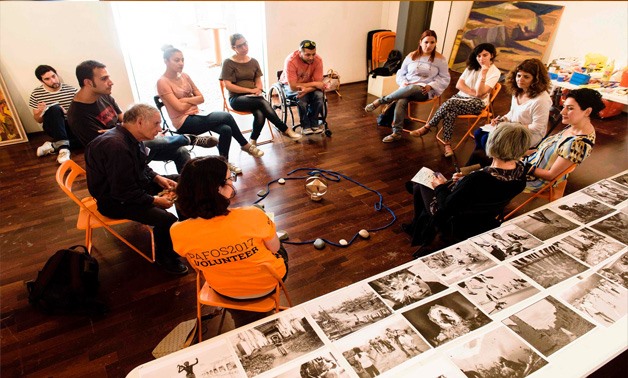
Turkish and Greek Cypriots attend an art therapy workshop to overcome painful memories of a conflict that split the island in two.
Paphos, Cyprus - 9 June 2017: Inside an art gallery on the divided Mediterranean island of Cyprus, Selma Bolayir draws a large yellow sun on a black-and-white picture of a South Vietnamese soldier who appears to be crying.
"When I look (at) this young soldier, I feel so upset, because I am a mother," says the elegant 73-year-old, her eyes outlined with black eye liner.
"In all the wars, the losers are the soldiers, the mothers and the children," says the Turkish Cypriot.
Bolayir is in Paphos to take part in an art therapy session, more than 40 years after fleeing the coastal town following a Turkish invasion of the island's north in 1974.
Around 200,000 people fled their homes on either side of the island after the incursion in response to an Athens-inspired coup seeking union with Greece.
In a population swap, Turkish Cypriots fled to the north and Greek Cypriots fled to the south.
Bolayir now lives in the northern half of Nicosia, Europe's last divided capital.
Decades later, she is one of around 10 Cypriots -- Turkish and Greek -- attending the workshop to overcome painful memories of the conflict that split the island in two.
Brightly coloured paint pots and black-and-white images of war from renowned photojournalists dot a table top.
Participants have each chosen a picture and are busy coating it with colour as a way of processing their individual and collective memories of traumatising events.
- 'We have to talk' -
Bolayir has picked a photograph taken by Nick Ut in 1974 of a South Vietnamese soldier sitting knees pulled up to his chest and head buried in his arms.
She has drawn a large sun behind the fighter and written a line inspired by Turkish poet Nazim Hikmet: "The sun will rise for us one day."
"I hope that one day, the sun will also rise for the Cypriots," she says, alluding to stalled peace talks for the island's reunification.
Her daughter Asli, who is an artist and therapist, says she set up the workshop to transform pain into hope.
"When you see a war picture, automatically you feel the violence," she says. We "transform it into something else".
"That's the purpose of the workshop: to change our point of view, our feelings."
Cypriots on both sides have suffered greatly and witnessed devastating violence, says Asli.
"We have to talk about it," she says, as the fragile peace talks enter their third year.
The workshop is one of several projects to encourage dialogue between Turkish and Greek Cypriots as Paphos is European Capital of Culture this year.
- 'Time to give back' -
At another gallery, the sculptures of both a Greek Cypriot and a Turkish Cypriot are exhibited side by side.
Most are by Greek Cypriot artist Andy Hadjiadamos, including an African-inspired elongated wooden man's bust.
In 1974, Hadjiadamos was forced to abandon his studio in the city of Famagusta in what is now the breakaway Turkish Republic of Northern Cyprus.
A Turkish Cypriot ended up saving the works he left behind.
Sculptor Baki Bogac says he instantly recognised the value of Hadjiadamos' works when he discovered them by chance two years after the Turkish invasion.
Bogac was part of a team surveying abandoned buildings in Famagusta, accompanied by Turkish troops.
He persuaded the soldiers to let him take a few works at a time and managed to gather a collection of paintings, drawings, photographs and a sculpture.
Years after looking after the works, Bogac searched for the artist to give him back his works but Hadjiadamos had died in 1990. Instead he met his family and handed over the treasure trove.
"I was really happy," says Bogac, now 66, at the recent opening of an exhibition of both their works.
"I came here as a real Cypriot, to show that you shouldn't take what doesn't belong to you," he said. "It's time to learn to give what we took -- more than we needed -- in this island."
"We can create something new, more pure, without keeping everything for ourselves," he told a crowd including Greek Cypriot President Nicos Anastasiades, his voice shaky with emotion.
Prodromos Andreou, a Greek Cypriot literature student, stood nearby inspecting Bogac's sculptures.
"It's very important that events like (these) happen in Cyprus to connect people and bring them closer," said the 27-year-old, a bag slung over his shoulder and trainers on his feet.
"Unfortunately many of them don't want to see them," he said, referring to some of his friends.


Comments
Leave a Comment